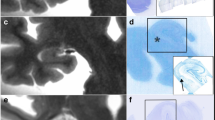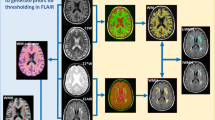Abstract
Objectives
This study examined the usefulness of statistical parametric mapping (SPM) for investigating postmortem changes on brain computed tomography (CT).
Methods
This retrospective study included 128 patients (23 − 100 years old) without cerebral abnormalities who underwent unenhanced brain CT before and after death. The antemortem CT (AMCT) scans and postmortem CT (PMCT) scans were spatially normalized using our original brain CT template, and postmortem changes of CT values (in Hounsfield units; HU) were analysed by the SPM technique.
Results
Compared with AMCT scans, 58.6 % and 98.4 % of PMCT scans showed loss of the cerebral sulci and an unclear grey matter (GM)–white matter (WM) interface, respectively. SPM analysis revealed a significant decrease in cortical GM density within 70 min after death on PMCT scans, suggesting cytotoxic brain oedema. Furthermore, there was a significant increase in the density of the WM, lenticular nucleus and thalamus more than 120 min after death.
Conclusions
The SPM technique demonstrated typical postmortem changes on brain CT scans, and revealed that the unclear GM–WM interface on early PMCT scans is caused by a rapid decrease in cortical GM density combined with a delayed increase in WM density. SPM may be useful for assessment of whole brain postmortem changes.
Key Points
• The original brain CT template achieved successful normalization of brain morphology.
• Postmortem changes in the brain were independent of sex.
• Cortical GM density decreased rapidly after death.
• WM and deep GM densities increased following cortical GM density change.
• SPM could be useful for assessment of whole brain postmortem changes.





Similar content being viewed by others
Abbreviations
- AMCT:
-
Antemortem computed tomography
- CT:
-
Computed tomography
- CPR:
-
Cardiopulmonary resuscitation
- GM:
-
Grey matter
- HU:
-
Hounsfield units
- MNI:
-
Montreal Neurological Institute
- MRI:
-
Magnetic resonance imaging
- PMCT:
-
Postmortem computed tomography
- SPM:
-
Statistical parametric mapping
- WM:
-
White matter
References
Charlier P, Carlier R, Roffi F et al (2012) Postmortem abdominal CT: assessing normal cadaveric modifications and pathological processes. Eur J Radiol 81:639–647
Sieswerda-Hoogendoorn T, Beenen LF, van Rijn RR (2015) Normal cranial postmortem CT findings in children. Forensic Sci Int 246:43–49
Ishida M, Gonoi W, Okuma H et al (2015) Common postmortem computed tomography findings following atraumatic death: Differentiation between normal postmortem changes and pathologic lesions. Korean J Radiol 16:798–809
Wichmann D, Obbelode F, Vogel H et al (2012) Virtual autopsy as an alternative to traditional medical autopsy in the intensive care unit: a prospective cohort study. Ann Intern Med 156:123–130
Okuda T, Shiotani S, Sakamoto N, Kobayashi T (2013) Background and current status of postmortem imaging in Japan: short history of “Autopsy imaging (Ai)”. Forensic Sci Int 225:3–8
O'Donnell C, Rotman A, Collett S, Woodford N (2007) Current status of routine post-mortem CT in Melbourne, Australia. Forensic Sci Med Pathol 3:226–232
Berger N, Ampanozi G, Schweitzer W et al (2015) Racking the brain: detection of cerebral edema on postmortem computed tomography compared with forensic autopsy. Eur J Radiol 84:643–651
Takahashi N, Satou C, Higuchi T, Shiotani M, Maeda H, Hirose Y (2010) Quantitative analysis of brain edema and swelling on early postmortem computed tomography: comparison with antemortem computed tomography. Jpn J Radiol 28:349–354
Torbey MT, Selim M, Knorr J, Bigelow C, Recht L (2000) Quantitative analysis of the loss of distinction between gray and white matter in comatose patients after cardiac arrest. Stroke 31:2163–2167
Kawakami K, Wake R, Miyaoka T, Furuya M, Liaury K, Horiguchi J (2014) The effects of aging on changes in regional cerebral blood flow in schizophrenia. Neuropsychobiology 69:202–209
Verfaillie SC, Adriaanse SM, Binnewijzend MA et al (2015) Cerebral perfusion and glucose metabolism in Alzheimer’s disease and frontotemporal dementia: two sides of the same coin? Eur Radiol 25:3050–3059
Chen B, Fan GG, Liu H, Wang S (2015) Changes in anatomical and functional connectivity of Parkinson's disease patients according to cognitive status. Eur J Radiol 84:1318–1324
Gillebert CR, Humphreys GW, Mantini D (2014) Automated delineation of stroke lesions using brain CT images. Neuroimage Clin 4:540–548
de Haan B, Clas P, Juenger H, Wilke M, Karnath HO (2015) Fast semi-automated lesion demarcation in stroke. Neuroimage Clin 9:69–74
Evans WA (1942) An encephalographic ratio for estimating ventricular enlargement and cerebral atrophy. Arch Neurol Psychiatry 47:931–937
Liang D, Bhatta S, Gerzanich V, Simard JM (2007) Cytotoxic edema: mechanisms of pathological cell swelling. Neurosurg Focus 22, E2
Levy AD, Harcke HT, Mallak CT (2010) Postmortem imaging: MDCT features of postmortem change and decomposition. Am J Forensic Med Pathol 31:12–17
Iida K, Satoh H, Arita K, Nakahara T, Kurisu K, Ohtani M (1997) Delayed hyperemia causing intracranial hypertension after cardiopulmonary resuscitation. Crit Care Med 25:971–976
Shirota G, Gonoi W, Ishida M et al (2015) Brain swelling and loss of gray and white matter differentiation in human postmortem cases by computed tomography. PLoS One 10, e0143848
Kobayashi T, Shiotani S, Kaga K et al (2010) Characteristic signal intensity changes on postmortem magnetic resonance imaging of the brain. Jpn J Radiol 28:8–14
Bidmon HJ, Kato K, Schleicher A, Witte OW, Zilles K (1998) Transient increase of manganese-superoxide dismutase in remote brain areas after focal photothrombotic cortical lesion. Stroke 29:203–210
van Etten ES, van der Grond J, Dumas EM, van den Bogaard SJ, van Buchem MA, Wermer MJ (2015) MRI susceptibility changes suggestive of iron deposition in the thalamus after ischemic stroke. Cerebrovasc Dis 40:67–72
Wang X, Qian J, He R et al (2006) Delayed changes in T1-weighted signal intensity in a rat model of 15-minute transient focal ischemia studied by magnetic resonance imaging/spectroscopy and synchrotron radiation X-ray fluorescence. Magn Reson Med 56:474–480
Liu XH, Kato H, Nakata N, Kogure K, Kato K (1993) An immunohistochemical study of copper/zinc superoxide dismutase and manganese superoxide dismutase in rat hippocampus after transient cerebral ischemia. Brain Res 625:29–37
Won SM, Lee JH, Park UJ, Gwag J, Gwag BJ, Lee YB (2011) Iron mediates endothelial cell damage and blood-brain barrier opening in the hippocampus after transient forebrain ischemia in rats. Exp Mol Med 43:121–128
Rorden C, Bonilha L, Fridriksson J, Bender B, Karnath HO (2012) Age-specific CT and MRI templates for spatial normalization. Neuroimage 61:957–965
Mak E, Su L, Williams GB et al (2015) Longitudinal assessment of global and regional atrophy rates in Alzheimer’s disease and dementia with Lewy bodies. Neuroimage Clin 7:456–462
Acknowledgments
We are grateful to Ms. S. Kodama, Mr. J. Iijima, Ms. Y. Nishiyama, Mr. M. Notsu, Ms. H. Maehara, Ms. Y. Hara, Mr. K. Nakao and Ms. S. Kageyama (Department of Radiology, Shimane University Hospital) for their technical support. The scientific guarantor of this publication is Hajime Kitagaki. The authors of this manuscript declare a relationship with the following company: Kazunori Kawakami is an employee of Fujifilm RI Pharma, Japan. The authors state that this work has not received any funding. Kazunori Kawakami kindly provided statistical advice for this manuscript and has significant statistical expertise. Institutional Review Board approval was obtained. Written informed consent was waived by the Institutional Review Board.
Methodology: retrospective, observational, performed at one institution.
Author information
Authors and Affiliations
Corresponding author
Rights and permissions
About this article
Cite this article
Nishiyama, Y., Kanayama, H., Mori, H. et al. Whole brain analysis of postmortem density changes of grey and white matter on computed tomography by statistical parametric mapping. Eur Radiol 27, 2317–2325 (2017). https://doi.org/10.1007/s00330-016-4633-7
Received:
Revised:
Accepted:
Published:
Issue Date:
DOI: https://doi.org/10.1007/s00330-016-4633-7




